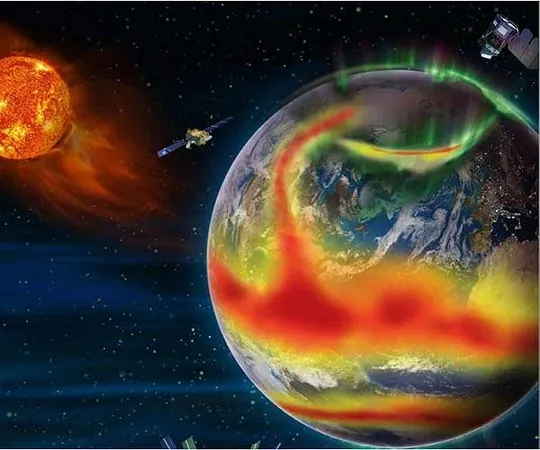
The Crucial Role of Space Weather in Safeguarding Our Planet
2025-01-13
Author: Emily
What Exactly is Space Weather?
Space weather refers to the environmental conditions in space driven primarily by the Sun’s activity. The Sun releases a continuous stream of charged particles, termed the solar wind, which influences Earth's magnetic field. This intricate interaction can lead to various disturbances on our planet, including solar flares and coronal mass ejections (CMEs) that unleash vast amounts of energy. These solar events can instigate geomagnetic storms that disrupt technology integral to our modern way of life—from communication systems to critical power grids.
The Ripple Effects of Space Weather on Technology
1. **Satellites and GPS Systems:** Intense solar radiation can impair satellite electronics, directly affecting communication signals and GPS accuracy. In sectors such as aviation and logistics, even slight GPS inaccuracies can result in significant delays and soaring operational costs. In extreme cases, geomagnetic storms can signal to satellites to malfunction or even shut down.
2. **Power Grids:** CMEs can induce electric currents in power lines that lead to transformer overloads and widespread outages. The infamous 1989 blackout in Quebec, which left millions without power, serves as a stark reminder of how vulnerable our interconnected power grids can be. As technology becomes more entwined, the stakes of underestimating space weather remain high.
3. **Aviation and Communication:** Solar activity can hinder airline operations, prompting flight reroutes and extended travel times due to increased radiation levels. Notably, military operations often depend on high-frequency radio communications, which can become compromised by disruptions in the ionosphere.
The Science Behind Space Weather Forecasts
Organizations like NASA and NOAA constantly monitor the Sun with advanced satellites, including the Solar and Heliospheric Observatory (SOHO). These observations help in identifying potential threats and estimating their impacts on Earth. They employ complex computer models that simulate solar event interactions with our planet’s magnetic field. While predicting space weather isn't as straightforward as terrestrial weather forecasting, the advancements in science offer valuable lead time for industries to mitigate potential damages.
Historical Context: Extreme Space Weather Events
- **The Carrington Event (1859):** This geomagnetic storm remains the most intense ever recorded. The disruption it caused to telegraph systems and its breathtaking auroras—visible as far south as the Caribbean—illustrate the potential chaos such an event could wreak in today’s infrastructure-rich society. - **The March 1989 Storm:** Born from a coronal mass ejection, this event crippled Quebec's power grid and damaged transformers across the U.S., compelling global attention to the vulnerabilities of power systems concerning space weather. - **The Halloween Storms of 2003:** These solar storms impacted satellite operations and prompted flight reroutes, demonstrating the far-reaching implications of space weather phenomena.
The Growing Significance of Space Weather Awareness
Our dependency on technology today means that satellites are pivotal for everything, from internet connectivity to disaster management. Damage to these systems could have ripple effects across various sectors, affecting economies and daily lives. High radiation levels from solar events also pose significant risks to astronauts, reinforcing the need for accurate predictions to protect crew members during missions beyond Earth. Furthermore, our understanding of climate phenomena is intertwined with solar activity. While space weather doesn’t directly instigate climate change, it can influence atmospheric conditions, altering weather patterns.
Preparing for Tomorrow: Steps Forward
1. **Stronger International Collaboration:** Agencies like NASA, ESA, and NOAA are joining forces with countries across the globe to enhance data sharing and early warning systems. 2. **Resilient Infrastructure Investments:** Governments and industries are prioritizing infrastructure development that mitigates the adverse effects of space weather. This includes hardening power grids and building radiation-resistant satellites. 3. **Educational Initiatives:** Public understanding of space weather can lead to better preparedness for possible disruptions. Schools, media, and community outreach programs play essential roles in disseminating vital information.



 Brasil (PT)
Brasil (PT)
 Canada (EN)
Canada (EN)
 Chile (ES)
Chile (ES)
 Česko (CS)
Česko (CS)
 대한민국 (KO)
대한민국 (KO)
 España (ES)
España (ES)
 France (FR)
France (FR)
 Hong Kong (EN)
Hong Kong (EN)
 Italia (IT)
Italia (IT)
 日本 (JA)
日本 (JA)
 Magyarország (HU)
Magyarország (HU)
 Norge (NO)
Norge (NO)
 Polska (PL)
Polska (PL)
 Schweiz (DE)
Schweiz (DE)
 Singapore (EN)
Singapore (EN)
 Sverige (SV)
Sverige (SV)
 Suomi (FI)
Suomi (FI)
 Türkiye (TR)
Türkiye (TR)
 الإمارات العربية المتحدة (AR)
الإمارات العربية المتحدة (AR)